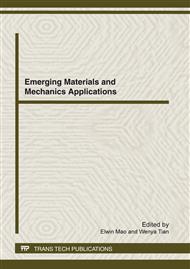p.644
p.649
p.653
p.658
p.663
p.668
p.672
p.677
p.682
Self-Assembly of Amphiphilic Block Copolymer in Aqueous Solutions Tuned by Host-Guest Inclusion Complexation
Abstract:
The block copolymer poly (ε-caprolactone)-b-poly (N-isopropyl acrylamide) (PCL-b-PNIPAM) is synthesized via the combination of ring-opening polymerization (ROP) and reversible addition-fragmentation chain transfer (RAFT). PCL-b-PNIPAM can self-assemble into the micelles taking PCL as the cores and PNIPAM as the shells. Add α-CD into the micelles, because the inclusion complexation of α-CD to PCL chains and phenols is stronger than that to PCL, to regulate the hydrophilic and hydrophobic features of PCL chain. So PCL-b-PNIPAM block copolymers have potential application in drug delivery and gene transfection.
Info:
Periodical:
Pages:
663-667
Citation:
Online since:
March 2012
Authors:
Keywords:
Price:
Сopyright:
© 2012 Trans Tech Publications Ltd. All Rights Reserved
Share:
Citation:


